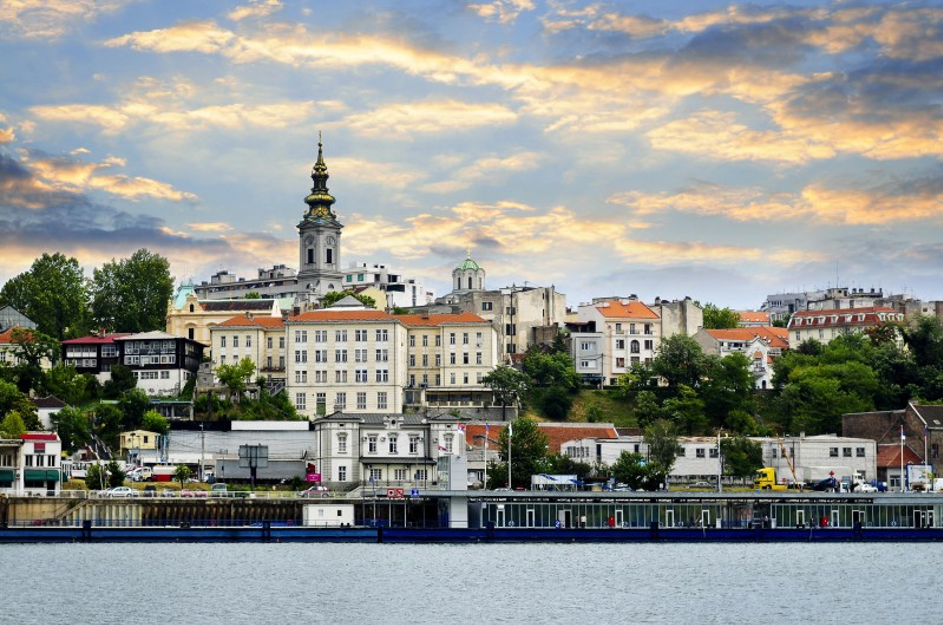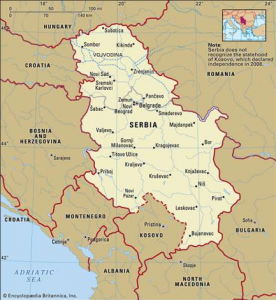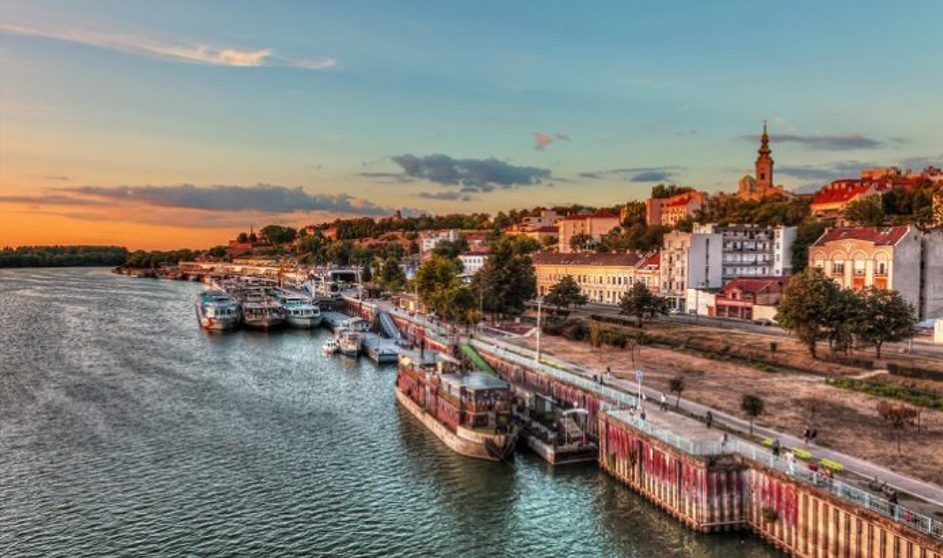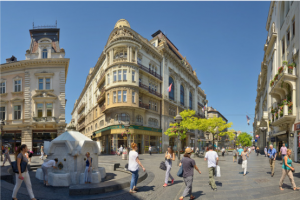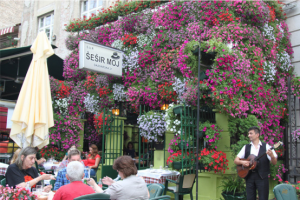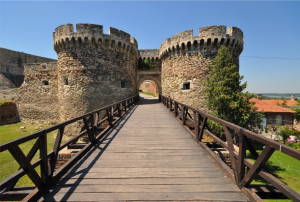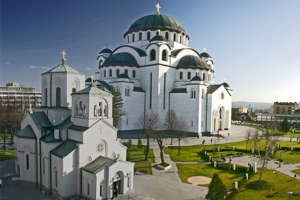Serbia, country in the west-central
Balkans. For most of the 20th century, it was a part of
Yugoslavia. The capital of Serbia is Belgrade (Beograd), a cosmopolitan city at the confluence of the Danube and Sava rivers; Stari Grad, Belgrade’s old town, is dominated by an ancient fortress called the Kalemegdan and includes well-preserved examples of medieval architecture and some of eastern Europe’s most-renowned restaurants.
Serbia Map, Encyclopedia Britannica, Inc. Belgrade is located at the convergence of three historically important routes of travel between Europe and the Balkans: an east-west route along the Danube River valley from Vienna to the Black Sea; another that runs westward along the valley of the Sava River toward Trieste and northern Italy; and a third running southeast along the valleys of the Morava and Vardar rivers to the Aegean Sea. To the north and west of Belgrade lies the Pannonian Basin, which includes the great grain-growing region of Vojvodina.
Danube River, Belgrade, Serbia Belgrade (Beograd) has a population of around 1.6 million. It is one of the oldest cities in Europe and has since ancient times been an important focal point for traffic, an intersection of the roads of Eastern and Western Europe. Belgrade is the capital of Serbian culture, education, science and economy. As a result of its tumultuous history, Belgrade has for centuries been home to many nationalities, with Serbs of the Orthodox Christian religion making up the majority of the population (90%). In the inner area of the City of Belgrade there are over 5,500 streets, 16 plazas and 32 squares. The oldest streets that have retained their original routes are: Vase Čarapića, Kralja Petra, Cara Dušana, Jevrejska, Narodnog fronta, Gavrila Principa, and Karađorđeva Streets. The development of the street network started in 1867, after the Turks had departed, when the regulatory plan of Belgrade was adopted, which had been drawn up by engineer Emilijan Josimović. In the territories of the 10 City municipalities, the oldest is the Student Square, and the most famous one is the Republic Square. Knez Mihailova Street is a pedestrian zone and shopping center - protected by law as one of the oldest and most valuable monumental complexes of the city, with a large number of representative buildings and urban houses built at the end of 1870s. High above the Sava and Danube confluence, on the rocky ridge which opens the view of Novi Beograd, Zemun and wide plains of Pannonia, there is the Belgrade Fortress with Kalemegdan, the former historical and urban center of Belgrade. Kalemegdan represents the most beautiful and biggest park in Belgrade, which is also the most important cultural and historical complex. The name Kalemegdan applies only to the spacious plateau surrounding the Fortress, which was turned into a park in the eighties of the XIX century. When the Fortress served as Belgrade's chief military stronghold, the plateau was a place from which the enemy was kept under observation and where preparations were made for combats. Its name derives from the Turkish words kale (fort) and megdan (field) - Kalemegdan. Kalemegdan now includes the Military Museum, Cvijeta Zuzorić Art Pavilion, City Institute for Protection of Cultural Monuments, Zoo, a children's amusement park, a large number of sports fields, restaurants and so on. Additional important sights in Belgrade are the National Museum, the National Theatre, the Palace of the Assembly of Serbia, the White Palace, Konak Kneza Miloša, Konak Kneginje Ljubice, Kapetan-Mišino Zdanje, Pobednik monument, etc. Belgrade is a city of culture. There are many museums, art galleries, churches and other famous buildings and sightseeing points offering interesting and original displays in the Old Town. Diverse neighborhoods will take you through the centuries, green parks will help you relax and provide outdoor activities.
Knez Mihailova Pedestrian zone and commercial center - Knez Mihailova Street is protected by law since it is one of the oldest and most important monumental urban environments. Knez Mihailova is composed of multiple buildings and representative houses constructed at the end of the 1870s. It is thought that the center of the population of Singidunum was established here during Roman times and that it was full of streets with gardens, fountains and mosques during the Ottoman Empire. After the elaboration of the Regulation of Urban Planning in 1867, the street was constructed rapidly to acquire its current.
Skadarlija Skadarlija as it Once Was This ambiental nook of Belgrade, still standing to this day, is preserved in the area of Skadarska Street around the bohemian Tri šešira inn. These were small houses, but a few of which remain. The house where the Tri šešira inn stands today is typical, built in the second half of the 19th century, the abode of former bohemians. The aqueduct of the Bulbulder waterway with 14 arches once stood in the middle of the mahala, in front of the subsequently built house of Đura Jakšić, as the sole reminder of times gone by.
During the 19th Belgrade Fortress The Belgrade Fortress changed and developed throughout the centuries, it saw many armies, was the field of many battles, it witnessed the brutality of the conquerors and the courage of the tireless defenders of the city. It was the place where Belgrade started to develop. The Fortress was built in stages, during the lengthy period between the 1st and 18th century, from a Roman castrum, through a Byzantine castle and the remains of the medieval capital of the Serb Despotate, all the way to an Austrian-Ottoman artillery fortification. The complex consists of the fortress itself, divided into.
Temple of Saint Sava Temple of Saint Sava (Hram Svetog Save) is the largest Serbian Orthodox church, the largest Orthodox place of worship in the Balkans and one of the largest Orthodox churches in the world. It is located on the eastern part of the Svetosavski Trg square on the Vračarski Plato in Belgrade. It was raised on the spot where it is thought that in 1595 Sinan-Pasha burned the relics of Saint Sava, founder of the Serbian Orthodox Church. This memorial cathedral is an organic component of Belgrade’s contemporary skyline, and one of its key features.
